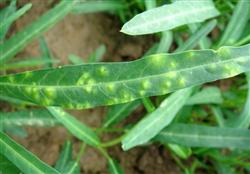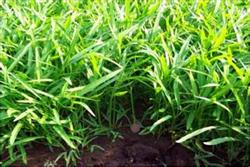Cultivation and management techniques of asparagus

Asparagus, also known as bamboo leaf vegetable, macaroni, water spinach, water spinach or rattan vegetable, is a kind of fast-growing green leafy vegetable introduced actively in recent years. The main management techniques are as follows: (1) the seed coat of cultivated seedlings is relatively thin and not hard, absorbs water faster, and dry seeds can be sown and germinated. Sprouting and sowing. If each greenhouse is 300 square meters, about 2.5 kilograms of seeds are needed. Soak the seeds with topiramate for 30 minutes, then wash them several times, and then soak the seeds in clean water for 22 hours. Pick it up and wash it, wrap it with gauze and put it into a 30-℃ incubator to accelerate budding. wait for the seeds to break and then sow. Before sowing, load the small stone rice to the planting cup 2x3, next to the seedling trough, about 2000 cups each, and put clean water to the planting cup 1max 3. Sow 3 seeds in each planting cup with the root tip down. After sowing, cover the seeds with a layer of small stone rice. Cover the trough surface with foam board to maintain the humidity in the trough and water frequently when dry. Accelerating germination and soaking seeds: the seed coat of hollow cabbage seeds is thick and hard, and if sowed directly, it will germinate slowly because of low temperature, and in case of long-term low temperature, overcast and rainy weather, it will cause seed rot, so it is appropriate to accelerate germination. Soak the seeds in warm water of about 30 ℃ for 18-20 hours, then wrap them with sand cloth and put them in a 30 ℃ germination box to accelerate germination. When the seeds are 50% and 60% white, they can be sown. (2) preparation work before planting 1. When selecting land, the land with sufficient sunshine and no shade should be selected, and the soil should be loose and breathable, the PH value should be appropriate and the moisture in the soil should be suitable, which must be suitable for the growth of hollow cabbage. 2. Soil preparation should be done before sowing. We should dig deep into the soil. If there are conditions, it is best to use rotary tillage machine for rotary tillage. The depth should be about 10-15cm. The border height can be determined by the root depth of asparagus, and the depth should be about 10-15cm. After leveling the soil, the bed should be made into a flat bed running from north to south. The width of the border should be about 1.2m. The ridge height is 0.2m and the width is 0.3m, in order to facilitate the future watering and other production management. We can cut off the bed every 0.3 meters or so. Weeds should be removed from the land before soil preparation. In order to avoid weeds and hollow cabbage seeds compete for nutrients. 3. The method of disinfection with base fertilizer is spread according to the standard of lime 100kg per 667m2. Spread evenly. After sowing, turn the soil layer deeply, the depth of the soil should be about 15-20cm, after the deep soil layer, the soil should be dried. After drying for 1-2 days, the seeds can be sown. (3) planting due to the growth of asparagus, it is necessary to plant in the later stage and remove the parts that are too dense, so that the spinach can grow better. After picking, it is necessary to water and apply some organic fertilizer to supplement nutrition. (4) Field management 1. After direct seeding, transplanting or cutting survived, combined with ploughing and weeding, 666.7 square meters of manure was applied to 1500kg of human and animal manure, and water was applied every 3-5 days. Fertilizer management about 10-15 days after sowing, when the seedlings grow to 4-6cm, we can lift the plastic film. If the film is not opened in time, the development of seedlings will be affected. And even cause the death of the young seedling. With the growth of asparagus seedlings. Other grasses will grow as they grow, and they will compete with asparagus for nutrients. It is not conducive to the growth of asparagus. So we have to carry out ploughing and weeding. All the weeds on the border should be pulled out. When ploughing the border surface. We should pay attention to ploughing so as not to hurt the plants. Otherwise, it is not conducive to the growth of plants. In the future field management, we should always pay attention to the weeds in the field, see the weeds and remove them in time, so as to ensure the good growth of asparagus. Asparagus is a crop that has been harvested many times, so in addition to applying sufficient base fertilizer, it is necessary to carry out multiple stages of topdressing in order to achieve high yield. the seedling stage can be applied with 1000-1500 kg of rare manure and urine at the seedling stage, and when the seedlings have 3-4 true leaves, 15-20 kg of compound fertilizer and 2-4 kg of urea are mixed with 15-20 kg of compound fertilizer and 2-4 kg of urea. 5-8 kg (per mu) of compound fertilizer is used for each harvest. 3. Water management looks at the dryness and wetness of the soil. If the soil is dry, it should be watered. When watering, the amount of water must be sufficient and should be drenched thoroughly. Let the soil fully absorb water. In the future daily management, generally speaking, watering can be carried out as long as the soil is relatively dry. Asparagus is a crop harvested many times, so in addition to applying sufficient base fertilizer, topdressing must be carried out in order to achieve high yield. When the seedlings of asparagus grow to 5-10cm, they can be fertilized for the first time. Topdressing should be carried out according to the standard of 500-700kg organic fertilizer per 667m2. When topdressing, the fertilizer should be diluted first, and then fertilized with watering. Fertilize evenly. Otherwise, if there is too much fertilizer in a certain place, the plants will be burned. Generally speaking, it is OK to have a top dressing before harvest. (5) timely harvest is the key to high yield and high quality of asparagus. Generally speaking, asparagus can be harvested when it grows to about 25cm to 35cm. If it is not harvested in time, it will not only affect the taste of hollow vegetables, but also reduce the yield. Asparagus is a vegetable that has been harvested many times. Generally speaking, asparagus cultivated in the open field can be harvested all the time until mid-late August. When harvesting, the asparagus should be harvested above 4-5cm above the ground. Don't hurt the roots of the asparagus. After harvesting, asparagus should be tied up in a bundle about every 1kg. Because asparagus is a crop that has been harvested many times, it should be fertilized in time combined with watering after harvest. Topdressing should be carried out according to the standard of 400-500kg organic fertilizer per 667m2. (6) there are few main diseases in the control of diseases and insect pests, and the insect pests are mainly whitefly. It can be sprayed with 1000-1500 times solution of mites nitrile. It should be sprayed once when the asparagus grows to about 8-10cm.
- Prev

How to control "white rust" of asparagus
Due to the high temperature and rain after the beginning of summer, asparagus is prone to white rust. Once the disease occurs, it not only reduces the yield, but also affects the quality. First, at the beginning of the onset of the symptoms, the disease spot appears yellowish to yellow spot on the front of the leaf, then gradually browns, the disease spot is larger, and the back of the leaf is white blister-like spot, nearly round or elliptical.
- Next

Key points of cultivation and Management of High quality and High yield of Ipomoea aquatica
First, sow seeds. Direct seeding in the open field, seedling transplanting can be done, and the sowing time is generally in the middle and late April. Direct seeding on the ground can be done by strip sowing or on-demand sowing, with row spacing 30 cm 35 cm, hole spacing 15 cm 20 cm, 3-4 seeds per hole, watering immediately after sowing, seedling emergence about 7 days, or secret sowing, when the seedling is 17-20 cm high.
Related
- Where is it suitable to grow horseradish in China? it is expected to see the middle altitude horseradish in Alishan.
- How to prevent tomato virus disease reasonably? (Control methods included)
- Many people like to plant towel gourd on the balcony. What are the main points of this method and management?
- What crops can chili peppers be mixed with?
- Fertilization techniques and matters needing attention in Tomato
- What are the grafting techniques for peach seedlings in spring?
- Harm and control methods of root swelling disease of Chinese cabbage
- What are the pests of sweet potatoes? How to prevent and cure it?
- Symptoms, causes and Control methods of navel Rot in Tomato
- The cause of "Cucumber rotten bibcock" in Farmers' planting Cucumber and its Control Plan

